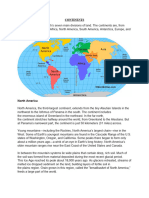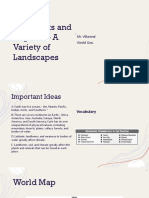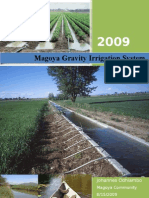Ancientafricamapactivity 1
Ancientafricamapactivity 1
Uploaded by
api-205540374Copyright:
Available Formats
Ancientafricamapactivity 1
Ancientafricamapactivity 1
Uploaded by
api-205540374Original Title
Copyright
Available Formats
Share this document
Did you find this document useful?
Is this content inappropriate?
Copyright:
Available Formats
Ancientafricamapactivity 1
Ancientafricamapactivity 1
Uploaded by
api-205540374Copyright:
Available Formats
Social Studies 6 Ancient Africa
Name _______________________ Date _______________________
Geography of Africa
Africa is the worlds second-largest continent, with an area of almost 12 million square miles By comparison, North Carolina has an area of approximately 50,000 square miles and the USA has about 4 million square miles of land. Africa is the only continent with land in all four hemispheres, since both the equator and prime meridian run through it. Africa is almost completely surrounded by water. The Red Sea is a long, narrow body of water on the north east corner of Africa, near the Gulf of Aden. The Mediterranean Sea is directly north of the continent and separates Africa from Europe. Oceans surround the rest of Africa. The Atlantic Ocean lies on the western side of Africa and the Indian Ocean lies to the east. Africa has few natural harbors. If you wanted to visit Africa by boat, you would have to hunt for a safe place to land. Without a safe harbor, powerful ocean currents would slam your boat into the rocks along the coastline.
Rivers are very important to the people of Africa. They provide fish for food, fresh water for irrigation and drinking, a means of transportation, and hydro-electric power that is generated near waterfalls. The three largest rivers in Africa are the Nile in the north east, the Niger in western Africa, and the Congo in the center of the continent. Africa is also the home to largest desert in the world, the Sahara, which stretches across the entire continent, from about 15N to almost the northern edge of the continent. Some of the sand dunes in the Sahara are seven hundred feet high! The worlds fourth largest desert, the Kalahari, is located in the southwest corner of Africa. The extreme southern tip of the continent, at the point where the Atlantic and Indian Oceans meet, is called the Cape of Good Hope. On the opposite end of the African land mass are the Atlas Mountains. They can be found along the North West coast of Africa, near the Mediterranean Sea, where Africa and Europe are closest to each other. The highest point in Africa is Mount Kilimanjaro, located approximately 400 miles east of Lake Victoria. It is nearly four miles high and is ranked as the worlds highest free-standing mountain. Africa is also home to the worlds fourth largest island, Madagascar, which is found approximately 250 miles off the southeast coast, in the southern part of the Indian Ocean. With 226,000 square miles, it is over four times larger than the state of North Carolina. A. Label the map: Read the article above and pay careful attention to the description of the places written in bold text and italics. Use the descriptions to help you decide where to write each name on the map on the back of this page. There are 13 places described in this article. Be sure to label all 13 of them on the map. B. Five Themes Chart: There are five phrases that are underlined. Each one is followed by a number from one to five. Place the number in the table to match that sentence or phrase to one of the Five Themes of Geography.
Theme Sentence or phrase from article (use number)
Location Place Movement Region HEI
C. How many times could North Carolina fit into the continent of Africa?
D. Write one complete sentence to summarize the main idea of the second paragraph . ______________________________________ ______________________________________ ______________________________________ ______________________________________
EUROPE
Byzantine Empire
20N
Gulf of Aden
Lake Victoria
_______________
20s
0 500 1000
10E
30E
E. Map questions: 1. On the map above, complete the key by writing the name of Ghana, Mali or Songhai on the line next to the solid, dashed or dotted lines. Use the maps on pages 327 + 335 of the Blue Book Eastern World. 2. What is the distance from the mouth of the Nile River to the mouth of the Congo River? _________miles 3. What is the width of Africa (east to west) at the equator. _________miles 4. Mount Kilimanjaro is (NE, SE, NW, SW) of the Gulf of Aden. 5. Which is the best estimate for the absolute location of the Niles mouth? 6. Which is the best estimate for the absolute location of Mt. Kilimanjaro? 7. Which is the best estimate for the absolute location of the Cape of good Hope? (15N, 30E) or (25N, 30E) (3N, 40E) or (3S, 40E) (25S, 20E) or (35S, 20E)
You might also like
- Lesson 1-Land and Resources of Africa Answer KeyDocument3 pagesLesson 1-Land and Resources of Africa Answer Keyheehee heehee100% (1)
- Ancient China Geography 1aDocument2 pagesAncient China Geography 1aapi-205540374100% (1)
- Checklist Requirements Screening EIS PhilippinesDocument7 pagesChecklist Requirements Screening EIS PhilippinesabadfredNo ratings yet
- Assignment 1Document8 pagesAssignment 1Mark Angelo S. EnriquezNo ratings yet
- PANGEADocument9 pagesPANGEAkim suchiraNo ratings yet
- Grade 6 Social Studies Weeks 1-4 Worksheets - Term 2Document48 pagesGrade 6 Social Studies Weeks 1-4 Worksheets - Term 2hummeraillahiNo ratings yet
- Grade 5 Geography Term 1 NotesDocument5 pagesGrade 5 Geography Term 1 NotespavithranaidooNo ratings yet
- Module 4 AfricaDocument89 pagesModule 4 AfricaRon PasionNo ratings yet
- AfricaDocument3 pagesAfricaa8477255No ratings yet
- 19 Script200304080803034646Document6 pages19 Script200304080803034646chahey825No ratings yet
- ss7g1 - Africa Geography 1 NotespptDocument51 pagesss7g1 - Africa Geography 1 Notespptapi-275304033No ratings yet
- Africa WebquestDocument3 pagesAfrica WebquestCatNo ratings yet
- Map Statements: Map 1:continents and OceansDocument3 pagesMap Statements: Map 1:continents and OceansSatMitNo ratings yet
- Oceans, Continents & CountriesDocument24 pagesOceans, Continents & CountriesImjai PromsatidkulNo ratings yet
- Land and Resources of AfricaDocument7 pagesLand and Resources of AfricaamyNo ratings yet
- AFRICADocument6 pagesAFRICAdiannemedel5No ratings yet
- AfricaDocument1 pageAfricabdsantiago92777No ratings yet
- American Civil War Era In A Nutshell And African Americans DiasporaFrom EverandAmerican Civil War Era In A Nutshell And African Americans DiasporaNo ratings yet
- Africa: Survey of Afroa-Asian LiteratureDocument20 pagesAfrica: Survey of Afroa-Asian Literatureshara santosNo ratings yet
- Lecture 1Document4 pagesLecture 1pyroarchon141No ratings yet
- Gloal Tourism ExamDocument8 pagesGloal Tourism ExamTrisha NicoleNo ratings yet
- Week 4 Continents-and-Oceans-of-the-World-PowerPointDocument49 pagesWeek 4 Continents-and-Oceans-of-the-World-PowerPointLeo DionedaNo ratings yet
- Africa 1Document121 pagesAfrica 1Micaella LalamoroNo ratings yet
- African Geography: Presented by Group 1Document11 pagesAfrican Geography: Presented by Group 1Third FabrosNo ratings yet
- AfricaDocument18 pagesAfricaSusie SabinaNo ratings yet
- Q.3 The Largest Countries in The WorldDocument11 pagesQ.3 The Largest Countries in The WorldNachiket AradhyeNo ratings yet
- Supplement 4 History and Geography 3 and 4Document8 pagesSupplement 4 History and Geography 3 and 4aldrichsefNo ratings yet
- Agg 2101: Development Geography of Africa PurposeDocument72 pagesAgg 2101: Development Geography of Africa PurposeChemutai EzekielNo ratings yet
- It Is The World's Largest Polar DesertDocument3 pagesIt Is The World's Largest Polar DesertMira AtanasovskaNo ratings yet
- Subject-Geography Topic-Earth's Empire By-Prajna - Kondapalli Class-6CDocument12 pagesSubject-Geography Topic-Earth's Empire By-Prajna - Kondapalli Class-6CRamakrishna KNo ratings yet
- Some Interesting Facts: African Culture HereDocument2 pagesSome Interesting Facts: African Culture HereYvonne BascoNo ratings yet
- Science ReviewerDocument8 pagesScience Reviewerleighalbano7No ratings yet
- The Seven ContinentsDocument4 pagesThe Seven ContinentsRonah Mae ManginlaudNo ratings yet
- Physical Geography of Central AfricaDocument3 pagesPhysical Geography of Central AfricaAstrid EspinozaNo ratings yet
- Grade 10 Geo Mid Exam 2015Document2 pagesGrade 10 Geo Mid Exam 2015abukiahmed07No ratings yet
- Africa Is SecondDocument13 pagesAfrica Is SecondTechnoratiNo ratings yet
- MAJOR DOMAINS OF THE EARTH WorksheetDocument1 pageMAJOR DOMAINS OF THE EARTH Worksheetvansh231213No ratings yet
- CONTINENTSDocument8 pagesCONTINENTSManjeet KaurNo ratings yet
- The World Around UsDocument13 pagesThe World Around Us31.hubaib-waniNo ratings yet
- Continents and Regions - A Variety of LandscapesDocument16 pagesContinents and Regions - A Variety of LandscapesJorge A VillarrealNo ratings yet
- Africa - InglêsDocument12 pagesAfrica - InglêsLaudino da CostaNo ratings yet
- Continents and Oceans: Write On Grade 3Document10 pagesContinents and Oceans: Write On Grade 3api-345686634No ratings yet
- Continents and Oceans Reading CompDocument3 pagesContinents and Oceans Reading CompDINESH CHANDRA GANNAVARAPUNo ratings yet
- Humanities Revision WorksheetDocument6 pagesHumanities Revision WorksheetTinyminnieNo ratings yet
- Land and Resources of Africa WSDocument3 pagesLand and Resources of Africa WSmusafrehman1No ratings yet
- AfricaDocument41 pagesAfricaMar SebastianNo ratings yet
- The Climate and Weather of AfricaDocument11 pagesThe Climate and Weather of AfricaTarek SouheilNo ratings yet
- Complete ListDocument4 pagesComplete ListSl2703No ratings yet
- Geo Final ExamDocument4 pagesGeo Final ExamTegebNo ratings yet
- What Are The 7 Continents 1Document4 pagesWhat Are The 7 Continents 1Yvs YcroNo ratings yet
- Africa ContinentDocument3 pagesAfrica ContinentMario Ivan Romero HernadezNo ratings yet
- AsiaDocument9 pagesAsiamarivic b.indopiaNo ratings yet
- Land and Resources of Africa Notebook WorkDocument3 pagesLand and Resources of Africa Notebook Worksaanjh05022011No ratings yet
- Global Culture and Tourism GeographyDocument7 pagesGlobal Culture and Tourism GeographyIvan ArenasNo ratings yet
- Knowledge Geography Africa PDFDocument7 pagesKnowledge Geography Africa PDFOliver SansumNo ratings yet
- Physical Geography of AfricaDocument23 pagesPhysical Geography of AfricaFalilou100% (1)
- Geography for Kids | Continents, Places and Our Planet Quiz Book for Kids | Children's Questions & Answer Game BooksFrom EverandGeography for Kids | Continents, Places and Our Planet Quiz Book for Kids | Children's Questions & Answer Game BooksNo ratings yet
- Pathways rw4 2e U7 TestDocument17 pagesPathways rw4 2e U7 Testabhh2298No ratings yet
- Geography of WorldDocument6 pagesGeography of WorldiamsyedfarhanshahNo ratings yet
- GeographyDocument7 pagesGeographyzainabshahzadi883No ratings yet
- 6th Religion Complete 1Document2 pages6th Religion Complete 1api-205540374No ratings yet
- Greek PhilosophersDocument2 pagesGreek Philosophersapi-205540374No ratings yet
- Rise of Islam 1Document3 pagesRise of Islam 1api-205540374No ratings yet
- 6th Gov Completed 3Document1 page6th Gov Completed 3api-205540374No ratings yet
- Ancient India Paideia Question 1aDocument2 pagesAncient India Paideia Question 1aapi-205540374No ratings yet
- Time Period of HistoryDocument11 pagesTime Period of Historyapi-205540374100% (1)
- Article of The Week Caste SystemDocument3 pagesArticle of The Week Caste Systemapi-205540374No ratings yet
- China in The Middle Ages 1aDocument4 pagesChina in The Middle Ages 1aapi-205540374No ratings yet
- Early China 2aDocument4 pagesEarly China 2aapi-205540374No ratings yet
- Ancient India Buddhism 1aDocument2 pagesAncient India Buddhism 1aapi-205540374No ratings yet
- India Map ActivityDocument2 pagesIndia Map Activityapi-205540374100% (1)
- Ancient India Hinduism 1aDocument2 pagesAncient India Hinduism 1aapi-205540374No ratings yet
- Ancient India 1aDocument4 pagesAncient India 1aapi-205540374No ratings yet
- Renaissanc VocabularyDocument3 pagesRenaissanc Vocabularyapi-205540374No ratings yet
- The CrusadesDocument3 pagesThe Crusadesapi-205540374No ratings yet
- Middle Ages Types of CastlesDocument3 pagesMiddle Ages Types of Castlesapi-205540374No ratings yet
- Brochure RubricDocument1 pageBrochure Rubricapi-205540374No ratings yet
- Middle Ages FeudalismDocument2 pagesMiddle Ages Feudalismapi-205540374No ratings yet
- Middle Ages Attacking and Defending A CastleDocument2 pagesMiddle Ages Attacking and Defending A Castleapi-205540374No ratings yet
- Middle Ages HousingDocument2 pagesMiddle Ages Housingapi-205540374No ratings yet
- TourismDocument3 pagesTourismnidhisasidharan0% (1)
- Flooding Durack Flood Flag MapDocument1 pageFlooding Durack Flood Flag MapNgaire TaylorNo ratings yet
- Malacañang Presidential Decree No. 1151 Philippine Environmental PolicyDocument4 pagesMalacañang Presidential Decree No. 1151 Philippine Environmental PolicyLouisa FerrarenNo ratings yet
- Counter Affidavit - Semirara (Final)Document34 pagesCounter Affidavit - Semirara (Final)Tokie Toki100% (1)
- Coastal Zone Management Status of BangladeshDocument34 pagesCoastal Zone Management Status of BangladeshMD SelimNo ratings yet
- Water R02Document261 pagesWater R02dequanzhouNo ratings yet
- An Overview Strategic Management Process and Concept of Decision MakingDocument9 pagesAn Overview Strategic Management Process and Concept of Decision MakingnahuNo ratings yet
- 71BDocument4 pages71BKatrina JohnsonNo ratings yet
- SWRB Social Work Practice Competencies - Self-Assessment 3 FinalDocument3 pagesSWRB Social Work Practice Competencies - Self-Assessment 3 Finalapi-291442969No ratings yet
- Dublin Statement On Water and Sustainable Development & Kalabagh DamDocument15 pagesDublin Statement On Water and Sustainable Development & Kalabagh DamAdil Javed ChaudharyNo ratings yet
- SK First Session MinutesDocument3 pagesSK First Session MinutesClaudine Ruales Ib-IbNo ratings yet
- Status Report - DBNWDDocument2 pagesStatus Report - DBNWDChickoLazaroNo ratings yet
- Buell (2005) Glossary - Envrionment, Nature, Place EtcDocument8 pagesBuell (2005) Glossary - Envrionment, Nature, Place EtcMohamed AchemlalNo ratings yet
- BWSSB Citizen Charter EnglishDocument16 pagesBWSSB Citizen Charter EnglishApurv SinghNo ratings yet
- The War On CulturwDocument6 pagesThe War On CulturwDreamay Alajero Bernas0% (1)
- Creating Cities: Gerry Tully - Designer and Partner, Proterra, IncDocument1 pageCreating Cities: Gerry Tully - Designer and Partner, Proterra, IncDustin Tyler JoyceNo ratings yet
- Swiss Competence in River Engineering and RestorationDocument213 pagesSwiss Competence in River Engineering and RestorationrasulconNo ratings yet
- 112TH Meeting of EAC On CRZDocument8 pages112TH Meeting of EAC On CRZkkodgeNo ratings yet
- Resource Oriented Public Toilet Design For Developing CountriesDocument148 pagesResource Oriented Public Toilet Design For Developing CountriesadijalanNo ratings yet
- Woolworths Prep SheetDocument2 pagesWoolworths Prep SheetMid-age ManNo ratings yet
- Aquatic Pollution and Wastewater Management Syllabus - 2022Document3 pagesAquatic Pollution and Wastewater Management Syllabus - 2022zirakumacoralineNo ratings yet
- SWOT Analysis Committee On Cultural Affairs and Committee On Community DevelopmentDocument3 pagesSWOT Analysis Committee On Cultural Affairs and Committee On Community DevelopmentJoey ArgonesNo ratings yet
- Well Log Response CharacterDocument20 pagesWell Log Response CharactertayofelaNo ratings yet
- Development of Magoya Gravity Irrigation SystemDocument6 pagesDevelopment of Magoya Gravity Irrigation SystemorodijoNo ratings yet
- Godrej's Sustainability Initiatives Towards SDGsDocument9 pagesGodrej's Sustainability Initiatives Towards SDGsAkanksha ChauhanNo ratings yet
- Relationship Between Business and EnvironmentDocument12 pagesRelationship Between Business and EnvironmentThe Random Guy100% (1)
- College EMS Self Audit ChecklistDocument8 pagesCollege EMS Self Audit ChecklistNiel Brian VillarazoNo ratings yet
- Cebu's Drinking Water Supply Diminishing': Elamparo Adrian P. 2012150212 October 16, 2013 AR153/AR1Document1 pageCebu's Drinking Water Supply Diminishing': Elamparo Adrian P. 2012150212 October 16, 2013 AR153/AR1Adrian Perez ElamparoNo ratings yet
- ES8923 EA Modernization Memo - Assignment Description - Fall 2019Document3 pagesES8923 EA Modernization Memo - Assignment Description - Fall 2019Umme SharmeenNo ratings yet














































































































